Chandrayaan-3 lands on the moon
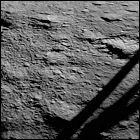 Launched by ISRO (Indian Space Research Organisation) in July, the Chandrayaan-3 uncrewed lunar lander successfully touches down on the surface of the moon near the lunar south pole, the first human-made spacecraft to successfully land in that region. Pictures from the surface are transmitted back to Earth, though the lander’s mission is to look for signs of subsurface water believed to be common in the shaded south pole region, a potentially vital resource for long-term human habitation of the moon. (This was the mission intended for the earlier, unsuccessful Chandrayaan-2 mission in 2018.) In accomplishing this feat, India becomes the fourth country to soft-land a payload on the lunar surface.
Launched by ISRO (Indian Space Research Organisation) in July, the Chandrayaan-3 uncrewed lunar lander successfully touches down on the surface of the moon near the lunar south pole, the first human-made spacecraft to successfully land in that region. Pictures from the surface are transmitted back to Earth, though the lander’s mission is to look for signs of subsurface water believed to be common in the shaded south pole region, a potentially vital resource for long-term human habitation of the moon. (This was the mission intended for the earlier, unsuccessful Chandrayaan-2 mission in 2018.) In accomplishing this feat, India becomes the fourth country to soft-land a payload on the lunar surface.
Luna 25 mission ends
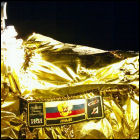 Russia’s Luna 25 mission to the lunar south pole ends unsuccessfully when an engine burn intended to lower the vehicle’s orbit around the moon into its final landing orbit goes awry. Luna 25 instead crashes into the moon as the result of the engine firing longer than expected. Contact with Luna 25 is not recovered following what the Russian space agency describes as an “abnormal situation”. The mission was Russia’s first attempt at a lunar landing in nearly 50 years.
Russia’s Luna 25 mission to the lunar south pole ends unsuccessfully when an engine burn intended to lower the vehicle’s orbit around the moon into its final landing orbit goes awry. Luna 25 instead crashes into the moon as the result of the engine firing longer than expected. Contact with Luna 25 is not recovered following what the Russian space agency describes as an “abnormal situation”. The mission was Russia’s first attempt at a lunar landing in nearly 50 years.
Luna 25
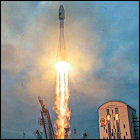 Russia launches the Luna 25 uncrewed spacecraft on a mission to land near the south pole of the moon. This is the first mission in the Luna program, which has been dormant since the 1970s; if successful, the mission will be the first Russian soft-landing on the moon in almost 50 years. Much like India’s Chanrayaan-3 mission, launched a few weeks earlier, Luna 25 is intended to search for signs of water in the shaded areas of the lunar south pole, which could be a necessary resource for future crewed missions and possible long-term habitation of the moon.
Russia launches the Luna 25 uncrewed spacecraft on a mission to land near the south pole of the moon. This is the first mission in the Luna program, which has been dormant since the 1970s; if successful, the mission will be the first Russian soft-landing on the moon in almost 50 years. Much like India’s Chanrayaan-3 mission, launched a few weeks earlier, Luna 25 is intended to search for signs of water in the shaded areas of the lunar south pole, which could be a necessary resource for future crewed missions and possible long-term habitation of the moon.
Chandrayaan-3
 India launches the Chandrayaan-3 uncrewed lunar lander mission, expected to reach the moon in August after weeks of gradually increasing the vehicle’s orbital altitude until it slips from Earth orbit into lunar orbit. The mission profile is very similar to that of the Chandrayaan-2 mission, which attempted to put a lunar lander named Vikram on the surface near the lunar south pole to look for signs of water.
India launches the Chandrayaan-3 uncrewed lunar lander mission, expected to reach the moon in August after weeks of gradually increasing the vehicle’s orbital altitude until it slips from Earth orbit into lunar orbit. The mission profile is very similar to that of the Chandrayaan-2 mission, which attempted to put a lunar lander named Vikram on the surface near the lunar south pole to look for signs of water.
Frank Drake, astronomer, dies
 Astronomer Dr. Frank Drake, one of the founders of SETI (the Search for Extra-Terrestrial Intelligences), dies at the age of 92. His fascinating with searching for life on other worlds began at a young age, and defined much of his life and career. In the 1960s, as part of a lecture, he devised the Drake Equation, a formula for calculating a very rough estimate of the possible number of civilizations capable of communicating across interstellar distances; this equation has been debated and challenged over the years, as well as gaining mainstream recognition after being cited in popular science programming (such as Carl Sagan’s Cosmos) and science fiction as well. In the 1970s, Drake and Sagan joined forces to create the “messages in bottles” affixed to the earliest space probes expected to break free of the solar system, including the Pioneer plaques and the golden records attached to Voyagers 1 and 2.
Astronomer Dr. Frank Drake, one of the founders of SETI (the Search for Extra-Terrestrial Intelligences), dies at the age of 92. His fascinating with searching for life on other worlds began at a young age, and defined much of his life and career. In the 1960s, as part of a lecture, he devised the Drake Equation, a formula for calculating a very rough estimate of the possible number of civilizations capable of communicating across interstellar distances; this equation has been debated and challenged over the years, as well as gaining mainstream recognition after being cited in popular science programming (such as Carl Sagan’s Cosmos) and science fiction as well. In the 1970s, Drake and Sagan joined forces to create the “messages in bottles” affixed to the earliest space probes expected to break free of the solar system, including the Pioneer plaques and the golden records attached to Voyagers 1 and 2.
James Webb Space Telescope launched
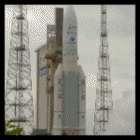 After well over a decade of development (and setbacks as the project fell in and out of favor with successive administrations of the U.S. government), the international James Webb Space Telescope is launched aboard an Ariane V rocket from the European Space Agency’s Kourou Space Center in French Guiana. Constructed and operated by NASA, the Webb Space Telescope is the larger successor to the Hubble Space Telescope, and its intricate, origami-like construction is expected to take a full month to deploy as the telescope travels to the L2 LaGrange point, well beyond the orbit of the moon. Its multi-segmented mirror is expected to see much more distant objects than Hubble was capable of resolving, possibly including the first galaxies to form in the history of the universe.
After well over a decade of development (and setbacks as the project fell in and out of favor with successive administrations of the U.S. government), the international James Webb Space Telescope is launched aboard an Ariane V rocket from the European Space Agency’s Kourou Space Center in French Guiana. Constructed and operated by NASA, the Webb Space Telescope is the larger successor to the Hubble Space Telescope, and its intricate, origami-like construction is expected to take a full month to deploy as the telescope travels to the L2 LaGrange point, well beyond the orbit of the moon. Its multi-segmented mirror is expected to see much more distant objects than Hubble was capable of resolving, possibly including the first galaxies to form in the history of the universe.
Launching Lucy
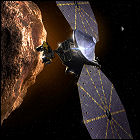 NASA launches the Lucy spacecraft on its twelve-year mission to study select specimens of the Trojan asteroid swarms that both precede and trail the planet Jupiter at the stable LaGrange points in its orbit. Lucy’s complex trajectory calls for it to conduct gravity assist flybys of Earth in 2022 and 2024, and to survey the main asteroid belt body 52246 Donaldjohanson in 2025, en route to reaching its first Trojan asteroid, 3548 Eurybates, in 2027. Future targets include 15094 Polymele later in 2027, 11351 Leucus and 21900 Orus in 2028, and – after a further gravity assist flyby of Earth in 2030 – the binary Trojan pair 617 Patroclus-Menoetius in 2033. Lucy’s name is not an abbreviation; it is named after a famous fossil skeleton discovered in 1971 by a team led by anthropologist David Johanson; it is hoped that studying the Trojan asteroids will lead to discoveries that make them similar “missing links” in the solar system’s own fossil record.
NASA launches the Lucy spacecraft on its twelve-year mission to study select specimens of the Trojan asteroid swarms that both precede and trail the planet Jupiter at the stable LaGrange points in its orbit. Lucy’s complex trajectory calls for it to conduct gravity assist flybys of Earth in 2022 and 2024, and to survey the main asteroid belt body 52246 Donaldjohanson in 2025, en route to reaching its first Trojan asteroid, 3548 Eurybates, in 2027. Future targets include 15094 Polymele later in 2027, 11351 Leucus and 21900 Orus in 2028, and – after a further gravity assist flyby of Earth in 2030 – the binary Trojan pair 617 Patroclus-Menoetius in 2033. Lucy’s name is not an abbreviation; it is named after a famous fossil skeleton discovered in 1971 by a team led by anthropologist David Johanson; it is hoped that studying the Trojan asteroids will lead to discoveries that make them similar “missing links” in the solar system’s own fossil record.
Charging the view of distant atmospheres
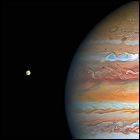 NASA and ESA announce that spectrographic analysis of Hubble Space Telescope data gathered during observations of Jupiter’s icy moon Europa reveals that Europa has a persistent atmosphere of water vapor, but only on the hemisphere of the moon that is opposite of the direction of its orbital motion. (This unusual effect had been predicted in computer modeling, but had not been directly observed until now.) The atmosphere is present in Hubble spectroscopy data as old as 1999 and as recent as 2015. The stability of the water vapor in the atmosphere is the real surprise find, since surface-based water was assumed to be in solid ice form.
NASA and ESA announce that spectrographic analysis of Hubble Space Telescope data gathered during observations of Jupiter’s icy moon Europa reveals that Europa has a persistent atmosphere of water vapor, but only on the hemisphere of the moon that is opposite of the direction of its orbital motion. (This unusual effect had been predicted in computer modeling, but had not been directly observed until now.) The atmosphere is present in Hubble spectroscopy data as old as 1999 and as recent as 2015. The stability of the water vapor in the atmosphere is the real surprise find, since surface-based water was assumed to be in solid ice form.
Hayabusa-2’s samples return to Earth
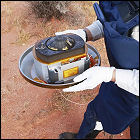 The Japanese space agency, JAXA, successfully recovers the Hayabusa-2 space probe’s sample return container after its return to Earth in Austrailia. The container’s precious cargo is 100 milligrams of surface and subsurface material retrieved by Hayabusa-2 from the surface of asteroid 162173 Ryugu during a series of touch-and-go maneuvers performed between February and July of 2019. Though it drops its samples off during a close flyby of Earth, Hayabusa-2 remains in space, where JAXA hopes to redirect it to study further asteroids, though the probe will no longer have the ability to gather or return samples.
The Japanese space agency, JAXA, successfully recovers the Hayabusa-2 space probe’s sample return container after its return to Earth in Austrailia. The container’s precious cargo is 100 milligrams of surface and subsurface material retrieved by Hayabusa-2 from the surface of asteroid 162173 Ryugu during a series of touch-and-go maneuvers performed between February and July of 2019. Though it drops its samples off during a close flyby of Earth, Hayabusa-2 remains in space, where JAXA hopes to redirect it to study further asteroids, though the probe will no longer have the ability to gather or return samples.
OSIRIS-REx Samples Bennu
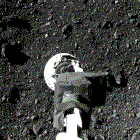 NASA’s OSIRIS-REx robotic spacecraft successfully gathers a generous sample of the surface regolith of asteroid 101955 Bennu on its first attempt, with some of the material estimated to originate from as deep as 49 centimeters beneath Bennu’s surface. (This result indicates that the asteroid’s surface is much softer and more pliable than expected.) The touchdown point was selected in conjunction with volunteer citizen scientists searching for safe places to gather a sample, and ruling out potential touchdown sites that appeared to be too hazardous. Intended to gather a minimum of 60 grams of material from Bennu, OSIRIS-REx is believed to have exceeded that minimum by a wide margin, and approval is given to stow the sample in its return container a week ahead of schedule. OSIRIS-REx will remain in Bennu’s orbit until March 2021, at which time it will fire its engines to begin its journey to return the samples of asteroid matter to Earth in September 2023.
NASA’s OSIRIS-REx robotic spacecraft successfully gathers a generous sample of the surface regolith of asteroid 101955 Bennu on its first attempt, with some of the material estimated to originate from as deep as 49 centimeters beneath Bennu’s surface. (This result indicates that the asteroid’s surface is much softer and more pliable than expected.) The touchdown point was selected in conjunction with volunteer citizen scientists searching for safe places to gather a sample, and ruling out potential touchdown sites that appeared to be too hazardous. Intended to gather a minimum of 60 grams of material from Bennu, OSIRIS-REx is believed to have exceeded that minimum by a wide margin, and approval is given to stow the sample in its return container a week ahead of schedule. OSIRIS-REx will remain in Bennu’s orbit until March 2021, at which time it will fire its engines to begin its journey to return the samples of asteroid matter to Earth in September 2023.
Perseverance Rover launched toward Mars
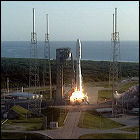 NASA launches the Perseverance Rover on its way to the planet Mars atop an Atlas V rocket. Though built around an assembly of flight spares left over from the Curosity Rover, Perseverance (known more formally as the Mars 2020 Rover) carries new experiments, including an ability to gather soil samples and seal them for pickup and return to Earth by a later (as yet unannounced) mission, over 20 built-in cameras, and – in a first for planetary exploration – a microphone designed to record the sounds of the Martian environment. Also attached to Perseverance is a drone, Ingenuity, designed for independent flight in the Martian atmosphere. Perseverance is aimed at Jezero Crater, an environment where liquid surface water is believed to have existed in Mars’ distant past, with a February 2021 landing date. The vehicle alarms ground controllers by going into a “safe mode” after launch, but communications and telemetry resume shortly afterward.
NASA launches the Perseverance Rover on its way to the planet Mars atop an Atlas V rocket. Though built around an assembly of flight spares left over from the Curosity Rover, Perseverance (known more formally as the Mars 2020 Rover) carries new experiments, including an ability to gather soil samples and seal them for pickup and return to Earth by a later (as yet unannounced) mission, over 20 built-in cameras, and – in a first for planetary exploration – a microphone designed to record the sounds of the Martian environment. Also attached to Perseverance is a drone, Ingenuity, designed for independent flight in the Martian atmosphere. Perseverance is aimed at Jezero Crater, an environment where liquid surface water is believed to have existed in Mars’ distant past, with a February 2021 landing date. The vehicle alarms ground controllers by going into a “safe mode” after launch, but communications and telemetry resume shortly afterward.
China launches Tianwen-1 toward Mars
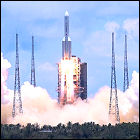 China launches the uncrewed Tianwen-1 space probe atop a Long March 5 rocket from the launch facilities in Wenchang. Intended to achieve orbit around Mars in February 2021, the spacecraft includes an orbiter and a lander/rover; the orbiter will look for suitable landing sites for the lander/rover combo, which is not expected to be dropped off until April 2021. The rover has soil gathering and analysis capabilities, while the orbiter has ground-penetrating radar. Tianwen-1 is intended to take up the unfulfilled mission objectives of the Yinghuo-1 orbiter, which was launched as a payload on Russia’s failed Fobos-Grunt mission in 2011 (which fell back into Earth’s atmosphere).
China launches the uncrewed Tianwen-1 space probe atop a Long March 5 rocket from the launch facilities in Wenchang. Intended to achieve orbit around Mars in February 2021, the spacecraft includes an orbiter and a lander/rover; the orbiter will look for suitable landing sites for the lander/rover combo, which is not expected to be dropped off until April 2021. The rover has soil gathering and analysis capabilities, while the orbiter has ground-penetrating radar. Tianwen-1 is intended to take up the unfulfilled mission objectives of the Yinghuo-1 orbiter, which was launched as a payload on Russia’s failed Fobos-Grunt mission in 2011 (which fell back into Earth’s atmosphere).
Emirates Mars Mission sends Hope to Mars
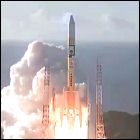 The United Arab Emirates launch their first uncrewed interplanetary mission, the Emirates Mars Mission, from Japan’s Tanegashima Space Center atop a Japanese H-IIA rocket. Expected to arrive at Mars in February 2021, the Hope orbiter will study Martian weather from orbit, not only serving as a true weather satellite for the red planet, but also gathering data on the factors leading to Martian atmosphere loss. The project, initiated in 2014, is intended not only to study Mars, but to attempt to gather a base of talent that could eventually build an Arab space industry.
The United Arab Emirates launch their first uncrewed interplanetary mission, the Emirates Mars Mission, from Japan’s Tanegashima Space Center atop a Japanese H-IIA rocket. Expected to arrive at Mars in February 2021, the Hope orbiter will study Martian weather from orbit, not only serving as a true weather satellite for the red planet, but also gathering data on the factors leading to Martian atmosphere loss. The project, initiated in 2014, is intended not only to study Mars, but to attempt to gather a base of talent that could eventually build an Arab space industry.
Hayabusa-2 now departing Ryugu
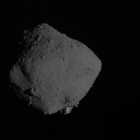 Japan’s Hayabusa-2 uncrewed spacecraft, carrying samples of material from asteroid 162173 Ryugu, begins its long trip home after spending nearly a year and a half in Ryugu’s orbit, where it deposited autonomous robotic landers and fired a projectile into Ryugu’s surface to loosen material for capture and return to Earth. First launched in 2014, Hayabusa-2’s return trajectory to Earth is expected to bring the samples of asteroid material home to a safe landing in Australia in late 2020.
Japan’s Hayabusa-2 uncrewed spacecraft, carrying samples of material from asteroid 162173 Ryugu, begins its long trip home after spending nearly a year and a half in Ryugu’s orbit, where it deposited autonomous robotic landers and fired a projectile into Ryugu’s surface to loosen material for capture and return to Earth. First launched in 2014, Hayabusa-2’s return trajectory to Earth is expected to bring the samples of asteroid material home to a safe landing in Australia in late 2020.
India’s Vikram lunar lander falls silent
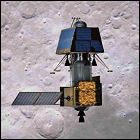 India’s mission to safely put a lander and an autonomous rover on the surface of the moon ends with a sudden loss of data. Deployed by the successful Chandrayaan-2 orbiter, the Vikram lander (carrying the Pragyan rover) begins a powered descent to the lunar surface, only to cease communicating with ground controllers in India at an altitude of 2.1 kilometers. With the speed of Vikram’s descent at the time of data loss measured at 60 meters per second via telemetry, ground controllers declare it likely that Vikram crashed into the moon, resulting in the loss of the vehicle and its payload, a fate somewhat similar to that of the Israel-launched Beresheet lander earlier in the year. The orbiter continues to function, and will search for signs of water ice at the south pole of the moon.
India’s mission to safely put a lander and an autonomous rover on the surface of the moon ends with a sudden loss of data. Deployed by the successful Chandrayaan-2 orbiter, the Vikram lander (carrying the Pragyan rover) begins a powered descent to the lunar surface, only to cease communicating with ground controllers in India at an altitude of 2.1 kilometers. With the speed of Vikram’s descent at the time of data loss measured at 60 meters per second via telemetry, ground controllers declare it likely that Vikram crashed into the moon, resulting in the loss of the vehicle and its payload, a fate somewhat similar to that of the Israel-launched Beresheet lander earlier in the year. The orbiter continues to function, and will search for signs of water ice at the south pole of the moon.
Chandrayaan-2 mission launched
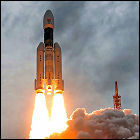 ISRO, India’s space agency, launches the Chandrayaan-2 mission to Earth’s moon, consisting of an orbiter and the Vikram/Prgyan lander/rover combination. The robotic vehicles are intended to conduct measurements, both from orbit and on the surface, of possible water ice deposits believed to exist at the lunar south pole. Much like the Beresheet mission launched by Israel earlier in the year, Chandrayaan-2 will employ a series of orbit-raising maneuvers until its apogee is high enough to propel it into lunar orbit with minimum reliance on burning fuel. The landing is expected to take place in September 2019.
ISRO, India’s space agency, launches the Chandrayaan-2 mission to Earth’s moon, consisting of an orbiter and the Vikram/Prgyan lander/rover combination. The robotic vehicles are intended to conduct measurements, both from orbit and on the surface, of possible water ice deposits believed to exist at the lunar south pole. Much like the Beresheet mission launched by Israel earlier in the year, Chandrayaan-2 will employ a series of orbit-raising maneuvers until its apogee is high enough to propel it into lunar orbit with minimum reliance on burning fuel. The landing is expected to take place in September 2019.
Beresheet attempts to land on the moon
 The Israeli-built Beresheet uncrewed experimental lunar lander, during its attempt to land on the moon, loses engine power during descent and plummets toward the lunar surface. Though the main engine is believed to have restarted during that descent, the vehicle is too low to make a survivable landing and crashes on the moon. The Google Lunar X Prize committee awards $1,000,000 to SpaceIL, the Israeli space exploration organization founded specifically to launch the Beresheet mission, and the mission’s backers vow to use the prize to build a second Beresheet lander to attempt to complete the original vehicle’s mission.
The Israeli-built Beresheet uncrewed experimental lunar lander, during its attempt to land on the moon, loses engine power during descent and plummets toward the lunar surface. Though the main engine is believed to have restarted during that descent, the vehicle is too low to make a survivable landing and crashes on the moon. The Google Lunar X Prize committee awards $1,000,000 to SpaceIL, the Israeli space exploration organization founded specifically to launch the Beresheet mission, and the mission’s backers vow to use the prize to build a second Beresheet lander to attempt to complete the original vehicle’s mission.
Beresheet launched
 The Israeli-built Beresheet uncrewed experimental lunar lander is launched from Cape Canaveral aboard a SpaceX Falcon 9 rocket. Originally intended as an entrant for the Google Lunar X Prize, Beresheet (and all the other hopefuls) missed the March 31, 2018 deadline, leaving the $20,000,000 Lunar X Prize unclaimed. Unlike past lunar missions, Beresheet is launched into a high Earth orbit, whose apogee (maximum distance from Earth) will be increased over a period of nearly two months with multiple burns of the vehicle’s main engine until it coincides with the orbital distance of the moon, at which time the engine will be fired again to place it in a lunar orbit prior to landing. The lander contains digital copies of numerous documents from Earth, reflecting the builders’ Jewish heritage as well as extensive databases of knowledge from sources such as Wikipedia. As the lander itself has not been built with protective shielding of any kind, its operational lifetime is expected to last only around two days on the lunar surface. If the mission succeeds, Israel will be the fourth nation (after the United States, Soviet-era Russia, and China) to land a spacecraft on the moon.
The Israeli-built Beresheet uncrewed experimental lunar lander is launched from Cape Canaveral aboard a SpaceX Falcon 9 rocket. Originally intended as an entrant for the Google Lunar X Prize, Beresheet (and all the other hopefuls) missed the March 31, 2018 deadline, leaving the $20,000,000 Lunar X Prize unclaimed. Unlike past lunar missions, Beresheet is launched into a high Earth orbit, whose apogee (maximum distance from Earth) will be increased over a period of nearly two months with multiple burns of the vehicle’s main engine until it coincides with the orbital distance of the moon, at which time the engine will be fired again to place it in a lunar orbit prior to landing. The lander contains digital copies of numerous documents from Earth, reflecting the builders’ Jewish heritage as well as extensive databases of knowledge from sources such as Wikipedia. As the lander itself has not been built with protective shielding of any kind, its operational lifetime is expected to last only around two days on the lunar surface. If the mission succeeds, Israel will be the fourth nation (after the United States, Soviet-era Russia, and China) to land a spacecraft on the moon.
New Horizons explores 2014 MU69
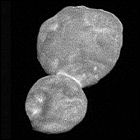 NASA’s New Horizons space probe, operated by Johns Hopkins University’s Applied Physics Lab, passes within 2,200 miles of the mysterious Kuiper Belt object 2014 MU69, a tiny fragment of leftover material from the birth of the solar system. Previously seen only as a tiny pixel even by the powerful lens of the Hubble Space Telescope, nothing was known of 2014 MU69 prior to the flyby, which revealed it as a contact binary: two bodies which had become gravitationally fused together. As 2014 MU69 (informally nicknamed Ultima Thule in a public poll conducted by the New Horizons public outreach team) is a billion miles further away than Pluto, and with New Horizons continuing outward at 30,000 miles per hour, signals between Earth and New Horizons take at least six hours to reach their destination, so the downlink of data from the flyby would take until 2020 to complete.
NASA’s New Horizons space probe, operated by Johns Hopkins University’s Applied Physics Lab, passes within 2,200 miles of the mysterious Kuiper Belt object 2014 MU69, a tiny fragment of leftover material from the birth of the solar system. Previously seen only as a tiny pixel even by the powerful lens of the Hubble Space Telescope, nothing was known of 2014 MU69 prior to the flyby, which revealed it as a contact binary: two bodies which had become gravitationally fused together. As 2014 MU69 (informally nicknamed Ultima Thule in a public poll conducted by the New Horizons public outreach team) is a billion miles further away than Pluto, and with New Horizons continuing outward at 30,000 miles per hour, signals between Earth and New Horizons take at least six hours to reach their destination, so the downlink of data from the flyby would take until 2020 to complete.
Chasing New Horizons
 Picador publishes the non-fiction book Chasing New Horizons: Inside The Epic First Mission To Pluto by scientists Alan Stern and David Grinspoon, retelling the story of Dr. Stern’s lengthy involvement in a movement to send a space probe to distant Pluto, and his eventual success as the principal investigator of the 21st century New Horizons mission, the first spacecraft to go there.
Picador publishes the non-fiction book Chasing New Horizons: Inside The Epic First Mission To Pluto by scientists Alan Stern and David Grinspoon, retelling the story of Dr. Stern’s lengthy involvement in a movement to send a space probe to distant Pluto, and his eventual success as the principal investigator of the 21st century New Horizons mission, the first spacecraft to go there.
Voyager 2 goes interstellar
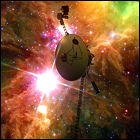 Launched in August 1977 prior to the departure of its sister ship, Voyager 1, NASA’s Voyager 2 space probe exits the heliosphere, the region where the solar wind from Earth’s sun has more influence than the interstellar medium between stars. Unlike Voyager 1, Voyager 2’s plasma science instruments are still working, so the instrument readings indicating a dramatic change in local space are very clear to the vehicle’s ground controllers (Voyager 1’s exit from the heliosphere in 2012 had been much more ambiguous at first). At over eleven billion miles from the Earth, radio signals take more than 16.5 hours to reach or be received from Voyager 2 at the time of its entry into the interstellar medium, and it is expected to return science data through the 2020s. It will pass within two years of the star Ross 248 in 40,000 years.
Launched in August 1977 prior to the departure of its sister ship, Voyager 1, NASA’s Voyager 2 space probe exits the heliosphere, the region where the solar wind from Earth’s sun has more influence than the interstellar medium between stars. Unlike Voyager 1, Voyager 2’s plasma science instruments are still working, so the instrument readings indicating a dramatic change in local space are very clear to the vehicle’s ground controllers (Voyager 1’s exit from the heliosphere in 2012 had been much more ambiguous at first). At over eleven billion miles from the Earth, radio signals take more than 16.5 hours to reach or be received from Voyager 2 at the time of its entry into the interstellar medium, and it is expected to return science data through the 2020s. It will pass within two years of the star Ross 248 in 40,000 years.
Brad Smith, Voyager imaging team lead, dies
 Bradford A. Smith, a research astronomer and former professor of planetary science and astronomy at the University of Arizona, dies at the age of 86 from complications arising from an autoimmune disorder. Smith became a public figure during the peak years of the uncrewed Voyager missions in the 1970s and ’80s, where, as the head of the imaging team for Voyagers 1 and 2, it fell to him to interpret freshly-received images from the outer planets and their moons for the press and the public, combining authoritative knowledge with a dry sense of humor at press conferences. Smith had reshaped the specs for Voyager’s onboard cameras since the mission was given the go-ahead in 1972, not only pushing for more powerful telescopic optics, but going out of his way to hire geologists and planetary science experts who could interpret the geological processes shaping the moons of Jupiter, Saturn, Uranus and Neptune from photos alone. When the moons of Jupiter greeted Voyager’s cameras with recently-reshaped surfaces and active volcanoes, that decision paid off. Prior to the Voyager mission, Smith had also been involved with imaging science in the Mariner and Viking missions to Mars, as well as helping to shape the specs for the planetary camera being developed for the yet-to-be-launched Hubble Space Telescope and advising imaging teams working on later missions.
Bradford A. Smith, a research astronomer and former professor of planetary science and astronomy at the University of Arizona, dies at the age of 86 from complications arising from an autoimmune disorder. Smith became a public figure during the peak years of the uncrewed Voyager missions in the 1970s and ’80s, where, as the head of the imaging team for Voyagers 1 and 2, it fell to him to interpret freshly-received images from the outer planets and their moons for the press and the public, combining authoritative knowledge with a dry sense of humor at press conferences. Smith had reshaped the specs for Voyager’s onboard cameras since the mission was given the go-ahead in 1972, not only pushing for more powerful telescopic optics, but going out of his way to hire geologists and planetary science experts who could interpret the geological processes shaping the moons of Jupiter, Saturn, Uranus and Neptune from photos alone. When the moons of Jupiter greeted Voyager’s cameras with recently-reshaped surfaces and active volcanoes, that decision paid off. Prior to the Voyager mission, Smith had also been involved with imaging science in the Mariner and Viking missions to Mars, as well as helping to shape the specs for the planetary camera being developed for the yet-to-be-launched Hubble Space Telescope and advising imaging teams working on later missions.
The maiden flight of GSLV Mark III
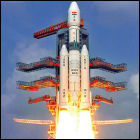 India’s space agency, ISRO (Indian Space Research Organization), successfully launches its first heavy-lift rocket, the GSLV Mark III, from Satish Dhawan Space Centre in Sriharikota. A massive launch vehicle capable of hefting 4-ton payloads into a geostationary orbit, GSLV Mark III’s first payload is the Indian government’s GSAT-19 communications satellite. ISRO also has its eyes on manned spaceflight, with later GSLV payloads potentially including a crewed vehicle to low Earth orbit.
India’s space agency, ISRO (Indian Space Research Organization), successfully launches its first heavy-lift rocket, the GSLV Mark III, from Satish Dhawan Space Centre in Sriharikota. A massive launch vehicle capable of hefting 4-ton payloads into a geostationary orbit, GSLV Mark III’s first payload is the Indian government’s GSAT-19 communications satellite. ISRO also has its eyes on manned spaceflight, with later GSLV payloads potentially including a crewed vehicle to low Earth orbit.
Europa Clipper
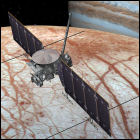 After a long process of gaining sufficient approval to be budgeted for a design phase, NASA’s Europa Clipper spacecraft gets a name and a preliminary shape, but no completion date or launch window any more specific than “the 2020s”, likely putting it at Jupiter’s intriguing moon Europa in the early 2030s after a series of gravity assists. Europa Clipper is intended to closely survey Europa from orbit, attempting to focus on its icy surface and the saltwater ocean believed to be hidden beneath that surface.
After a long process of gaining sufficient approval to be budgeted for a design phase, NASA’s Europa Clipper spacecraft gets a name and a preliminary shape, but no completion date or launch window any more specific than “the 2020s”, likely putting it at Jupiter’s intriguing moon Europa in the early 2030s after a series of gravity assists. Europa Clipper is intended to closely survey Europa from orbit, attempting to focus on its icy surface and the saltwater ocean believed to be hidden beneath that surface.
Dream Chaser Hubble repair mission proposed
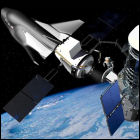 Though it has yet to actually go to space, the Sierra Nevada Dream Chaser spacecraft is floated as a possible savior for the Hubble Space Telescope, with a very preliminary mission proposal for a repair mission to the telescope which has now been operational in orbit for over a quarter of a century. The possible mission is brought forth as an example of increasing high-profile cooperation between NASA and private space companies. The Dream Chaser’s earliest orbit test flights are not expected to take place prior to 2019; if the mission takes place in 2020 at the earliest, Hubble will by then be 30 years old.
Though it has yet to actually go to space, the Sierra Nevada Dream Chaser spacecraft is floated as a possible savior for the Hubble Space Telescope, with a very preliminary mission proposal for a repair mission to the telescope which has now been operational in orbit for over a quarter of a century. The possible mission is brought forth as an example of increasing high-profile cooperation between NASA and private space companies. The Dream Chaser’s earliest orbit test flights are not expected to take place prior to 2019; if the mission takes place in 2020 at the earliest, Hubble will by then be 30 years old.
Juno: close, but no science
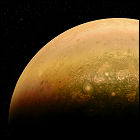 NASA’s Juno space probe makes a third close swing past Jupiter, but engineering problems make it a blind pass: concerns over stuck valves in the engine leads ground controllers to cancel a planned engine burn to shorten the length of Juno’s orbit, and then mere hours before its latest close pass, Juno goes into a safe mode which shuts down all instruments and cameras pending intervention from Earth. Juno principal investigator Scott Bolton assures that Juno could, theoretically, complete its mission with longer, unadjusted orbits if need be; Juno’s next close pass by Jupiter is expected to happen in December, impacting all future events in the mission plan.
NASA’s Juno space probe makes a third close swing past Jupiter, but engineering problems make it a blind pass: concerns over stuck valves in the engine leads ground controllers to cancel a planned engine burn to shorten the length of Juno’s orbit, and then mere hours before its latest close pass, Juno goes into a safe mode which shuts down all instruments and cameras pending intervention from Earth. Juno principal investigator Scott Bolton assures that Juno could, theoretically, complete its mission with longer, unadjusted orbits if need be; Juno’s next close pass by Jupiter is expected to happen in December, impacting all future events in the mission plan.
ExoMars Trace Gas Orbiter & Schiaparelli arrive
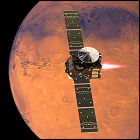 The European Space Agency’s ExoMars Trace Gas Orbiter and accompanying Schiaparelli Entry Demonstration Lander arrive at the red planet, with the orbiter successfully completing a lengthy engine burn to put it into orbit around Mars; it is the second ESA orbiter to reach Mars, with Mars Express still operating in an elliptical polar orbit. The lander, however, is not so lucky in reaching its goal: its signal, monitored both by the Trace Gas Orbiter and by Mars Express, abruptly ends near the surface; later analysis, and a Mars Reconnaissance Orbiter sighting of debris on Mars, lead ESA engineers to conclude that the lander’s parachute was jettisoned too soon, leaving it to plummet to the ground. This is but the first wave of an expected ExoMars program, a joint venture between ESA and the Russian space program.
The European Space Agency’s ExoMars Trace Gas Orbiter and accompanying Schiaparelli Entry Demonstration Lander arrive at the red planet, with the orbiter successfully completing a lengthy engine burn to put it into orbit around Mars; it is the second ESA orbiter to reach Mars, with Mars Express still operating in an elliptical polar orbit. The lander, however, is not so lucky in reaching its goal: its signal, monitored both by the Trace Gas Orbiter and by Mars Express, abruptly ends near the surface; later analysis, and a Mars Reconnaissance Orbiter sighting of debris on Mars, lead ESA engineers to conclude that the lander’s parachute was jettisoned too soon, leaving it to plummet to the ground. This is but the first wave of an expected ExoMars program, a joint venture between ESA and the Russian space program.
OSIRIS-REx
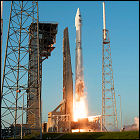 NASA launches the unmanned OSIRIS-REx (Origins Spectral Interpretation Resource Identification Security Regolith Explorer) spacecraft, bound for the asteroid Bennu, a target it won’t reach for two years. Once at Bennu, OSIRIS-REx is intended to orbit the asteroid and then drop down close enough to gather surface samples for return to Earth in a small sample container capable of surviving re-entry through the atmosphere. The samples from Bennu, an asteroid considered a hazard for Earth in the future, will not arrive until September 2023.
NASA launches the unmanned OSIRIS-REx (Origins Spectral Interpretation Resource Identification Security Regolith Explorer) spacecraft, bound for the asteroid Bennu, a target it won’t reach for two years. Once at Bennu, OSIRIS-REx is intended to orbit the asteroid and then drop down close enough to gather surface samples for return to Earth in a small sample container capable of surviving re-entry through the atmosphere. The samples from Bennu, an asteroid considered a hazard for Earth in the future, will not arrive until September 2023.
Finding Philae
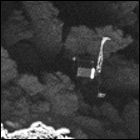 With mere weeks left before the European Space Agency’s Rosetta space probe is shut down, the spacecraft’s gradually decreasing orbit allows it to see more fine detail on the surface of Comet 67P/Churyumov–Gerasimenko, which is now outbound near the orbit of Jupiter. Rosetta’s surface survey finally reveals the fate of the short-lived Philae lander: as ESA engineers suspected in 2014, it came to rest on its side in a crevasse, preventing its batteries from recharging via its solar panels. Originally aimed at the Agilkia region on the larger of Comet 67P’s two “lobes”, Philae’s harpoon anchoring system failed to fire, leaving the lander to bounce helplessly into a ravine on the smaller lobe of the comet, in the Abydos region. It only relayed its surface findings to Rosetta for three days in late 2014. Rosetta would soon join Philae on the surface, with a surface impact scheduled for September 30, 2016.
With mere weeks left before the European Space Agency’s Rosetta space probe is shut down, the spacecraft’s gradually decreasing orbit allows it to see more fine detail on the surface of Comet 67P/Churyumov–Gerasimenko, which is now outbound near the orbit of Jupiter. Rosetta’s surface survey finally reveals the fate of the short-lived Philae lander: as ESA engineers suspected in 2014, it came to rest on its side in a crevasse, preventing its batteries from recharging via its solar panels. Originally aimed at the Agilkia region on the larger of Comet 67P’s two “lobes”, Philae’s harpoon anchoring system failed to fire, leaving the lander to bounce helplessly into a ravine on the smaller lobe of the comet, in the Abydos region. It only relayed its surface findings to Rosetta for three days in late 2014. Rosetta would soon join Philae on the surface, with a surface impact scheduled for September 30, 2016.
Juno gets up close and personal with Jupiter
 NASA’s Juno spacecraft completes its first orbit of giant planet Jupiter with an orbit-shaping manever that takes it as close to Jupiter’s cloudtops as 2,600 miles – less than the width of the continental United States – at a speed of over 100,000 miles per hour. Juno obtains the first close-up views of the north and south poles of the planet, revealing a roiling hotbed of storm activity unlike the poles of relatively quiet Saturn. In addition to photos, Juno scans the planet in the infrared and ultraviolet portions of the spectrum. This is scheduled to be Juno’s closest flyby of its entire mission.
NASA’s Juno spacecraft completes its first orbit of giant planet Jupiter with an orbit-shaping manever that takes it as close to Jupiter’s cloudtops as 2,600 miles – less than the width of the continental United States – at a speed of over 100,000 miles per hour. Juno obtains the first close-up views of the north and south poles of the planet, revealing a roiling hotbed of storm activity unlike the poles of relatively quiet Saturn. In addition to photos, Juno scans the planet in the infrared and ultraviolet portions of the spectrum. This is scheduled to be Juno’s closest flyby of its entire mission.